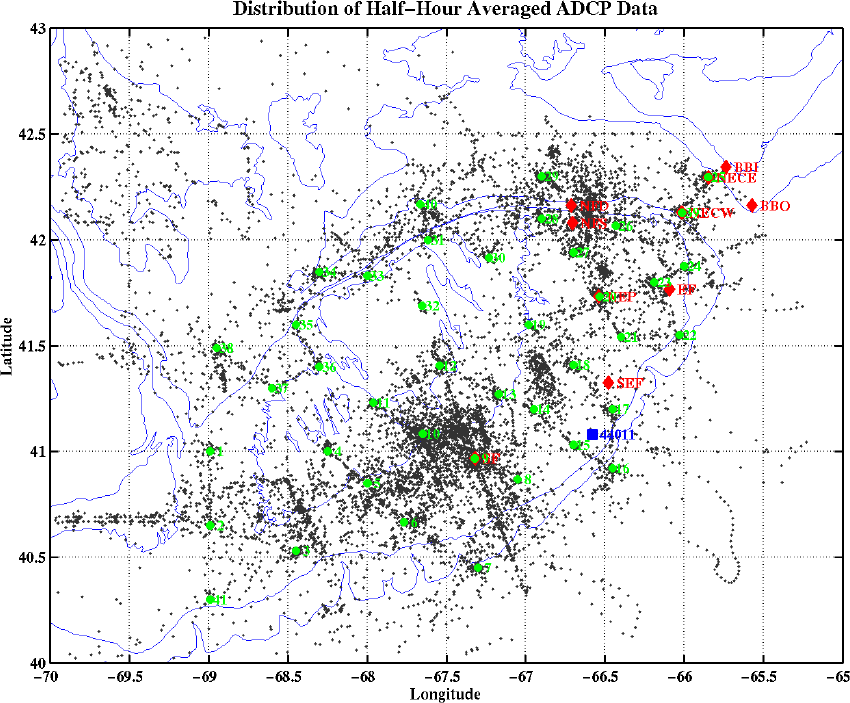

This web-page contains the results of the shipboard ADCP data collection effort for GLOBEC's Georges Bank Project. The ADCP data has been acquired onboard the RV Endeavor, the RV Oceanus, the Edwin Link, and the Albatross IV for each GLOBEC cruise. At the end of each cruise the pingdata files are sent to us for processing. The vast majority of the data has been collected using 150 kHz narrow-band ADCPs although there have been a number of cruises on the RV Albatross which is equipped with a broad-band unit. Recently, we have completed the modification and development of the routines required to deal with the broad-band data and those cruises are now being gradually included in the ADCP archive.
The ADCP data are processed using the CODAS3 shipboard ADCP processing programs developed by the University of Hawaii with additional capabilities developed at Brookhaven. As the data from each cruise is processed, it is made accessible through this web page which allows for the downloading of user specified portions from each cruise in either flat-ASCII or matfile formats. Cruise plots are available for viewing which show the spatial extent of the data coverage for each cruise. The broadscale cruises typically provide the widest coverage although some of the process cruises have excellent coverage in limited areas.
The assistance of Bill Fanning, Jim Akens, Laura Goepfert, Melissa Lamont, and Jim Manning in overseeing the shipboard collection and forwarding of the ADCP data to BNL is gratefully acknowledged.
As part of the analysis of the ADCP data set, we have embarked upon a hindcast modelling effort based upon the work of the Dartmouth/UNC/WHOI/NMFS/BIO/BNL realtime modelling program. The goal is to provide realistic spatial and temporal interpolations of the ADCP currents over the Bank for as many cruises as possible in order to study the large-scale mean and seasonal flow patterns. The hindcast process uses a fully non-linear forward model and a variety of linearized inverse models in an iterative procedure to capture as much of the observed variability in the ADCP data as possible. The resulting model fields then provide a reasonable spatial and temporal prediction of the currents and property distributions over the Bank during the cruise period. Results from the hindcast modelling are also being made accessible through this web site as they become available. The basic results of the model come in the form of hourly barotropic currents and sea-level and complete 3-D results for the model domain at six-hourly intervals. The current version of the hindcast model uses the Bank150 grid, a map of which can be viewed by clicking here. The invaluable assistance of Chris Naimie, Jim Manning and Brian Blanton in setting this program up is much appreciated.
Below is a map showing the areal distribution of the ADCP data collected and processed to date. SInce the basic data collection was conducted at 5 minute intervals, the actual number of velocity profiles is six times that shown in the figure. Included on the figure are the locations of the broad-scale survey stations (green), most of the mooring locations (red), and the NDBC acean data buoy 44011 (blue). Included in the ADCP data set are all the data from the GLOBEC program when the shipboard ADCPs were functioing, plus data from other programs whose cruises traversed over or near Georges Bank during the GLOBEC field period.

The timeline below shows when ADCP data were collected by the three principle GLOBEC vessels, the ENDEAVOR, OCEANUS, and ALBATROSS. A minor amount of data was also collected by the EDWIN LINK and SEWARD JOHNSON, some of which is of sufficient quality to be available below.. Also not shown are the data from the Canadian vessels PARIZEAU and HUDSON which will add coverage to the eastern Bank, the Northeast Channel, and Browns Bank. These data recently arrived and have yet to be processed.

Click here to see the study area.
NEW Tidal Prediction Routines Based Upon the ADCP Data: We have also developed some NEW matlab routines to determine the vertically averaged tidal currents in the GLOBEC study region. The routines can predict tidal currents for any specified time and position in the region. Here is a map of the tidal analysis region. You can also download the matlab routines from here and unzip the packaged zip file with info-ZIP's unzip utility. If you prefer to use the previous version, it may be downloaded here
Cruises:
* PLEASE NOTE: A minor calibration error was detected and corrected. All of the necessary corrections were performed between 7/28/00 to 10/3/00.
* Due to an erroneous dip switch toggle on the Endeavor ADCP (discovered by Jules Hummond and Daryl Symonds), the 1999 Endeavor ADCP data contained errors. The errant profiles (approx 2%) were removed and affected datasets completely reprocesses on 3/12/01.
Any questions, please contact Charles Flagg